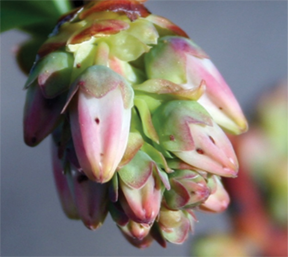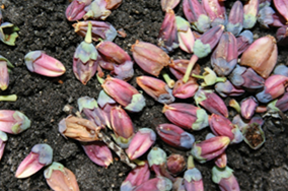Decoded Secret Betrays Berry Weevil
 |
|
Pinhole-sized access holes in swelling buds mean cranberry weevils laid eggs here. Photo by Zsofia Szendrei |
You have to look sharp to see cranberry weevils. Adults are small, and newly hatched larvae are positively tiny. They feed on blueberries as well as cranberries—and lumped together, these crops carry a $200-plus million value each year. The weevils aren’t widespread in North America. “But if you’ve got them,” says César Rodriguez-Saona, “you could take a serious hit.”
Today’s tactics aren’t equal to the threat. In New Jersey, a major center of U.S. blueberry and cranberry production, Rutgers University’s Rodriguez-Saona wants answers. Northeastern IPM funding has helped.
Beating the Bushes for Weevils
Scouting for weevils is labor-intensive. Growers use beating sheets on blueberries or sweep nets among cranberries. Lures and traps would save precious time, and time is money. But until Rodriguez-Saona took to the field, no cranberry weevil pheromone had been identified, let alone tested to use in a lure.
Pheromones are the chemical signals insects and other animals emit to guide, attract, alarm, or repel those of their kind. Scientists have found that attraction or aggregation pheromones (“calling all weevils!”) tend to work best on lures. Lures are often combined with traps, making it easier to estimate pest populations.
Each pheromone is really a blend, rather like a perfume. Many species make use of the same basic ingredients, blending them in their own secret way. So the first step in creating a lure is to decode how an insect formulates its proprietary blends.
In 2008 Rodriguez-Saona, along with Anne Averill at the University of Massachusetts, Zsofia Szendrei at Michigan State, and Hans Alborn at the USDA’s Agricultural Research Service, identified four cranberry weevil pheromone components. Three were emitted only by males. Both males and females produced the fourth.
See No Weevil
In 2009, Rodriguez-Saona mixed several blends for testing. He didn’t know yet which pheromone components (and in what proportions) would prove most attractive. For some pests, a single-compound lure is enough. For others, a blend works best. The hope: through trial and error, to hit on a mix they can’t resist.
 |
|
Buds drop as larvae feed within; they pupate inside the dry, shriveled husks. Photo by Zsofia Szendrei |
Soon Rodriguez-Saona’s first generation lures—sticky traps baited with a range of pheromone components—were attracting cranberry weevils. The best-performing lure included the four-component pheromone blend.
Next, Rodriguez-Saona wanted to test his traps in combination with new reduced-risk pesticides such as Avaunt to see if the traps would help growers time these new, “softer” pesticides to have an impact comparable to “grower standard” sprays. So in 2010 he took his traps to four New Jersey blueberry farms.
Results? The current lure needs a bit more adjusting to better attract cranberry weevils. Even so, the research shows that Avaunt provides good cranberry weevil control—and that lures, once improved, could help growers time their spray for greatest effectiveness. Now the current Avaunt label for blueberries is being updated to include cranberry weevil.
Next on the agenda: trials of varying trap colors, designs, placement, and formulations. The goal: to create a combination so compelling it’s a magnet for weevils.
— by MARY WOODSEN
The Northeastern IPM Center promotes integrated pest management for reducing risks to human health and the environment. If republishing our news, please acknowledge the source (“From Northeast IPM Insights”) along with a link to our website.
